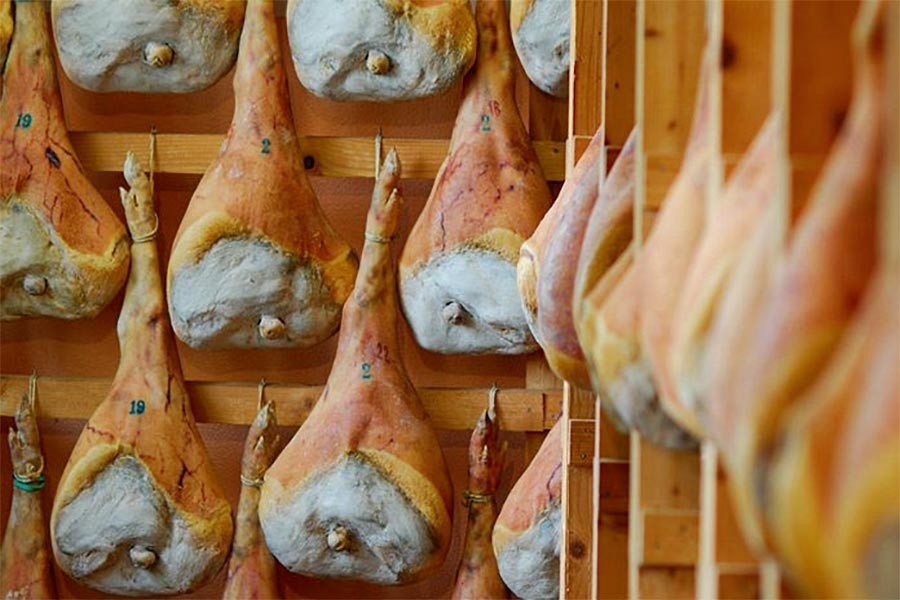San Daniele Cured Raw Ham P.D.O.
Product description
Prosciutto di San Daniele PDO is a cured charcuterie product obtained through the processing of fresh legs from Italian heavy pigs born, reared and slaughtered in 10 North Central regions in Italy.
Production method
Processing begins with the weighing of the legs, which must be at least 12 kg. They are then trimmed to remove any imperfections caused by slaughtering.
The meat is then salted for a period of time that depends on the weight of the leg; tradition requires that the leg remains in the salt for one day per kilo of the total weight.
The leg is then cleaned of the salt and pressed for 24-48 hours, in order to give it its characteristic shape. It is then left to rest, after which it is washed, dried and greased.
It is then ready to move on to the most important stage: curing. It is during this process that the microclimate of San Daniele comes into play.
The curing process lasts for a minimum of 13 months, starting from the date in which it enters the pork processing plant.
If after the curing process the ham meets the requirements specified by the Product Specification, it is fire-branded with the Consortium logo that guarantees its authenticity.
Apparence and flavour
Prosciutto di San Daniele PDO is shaped like a guitar and when cut it has a uniform reddish-pink colour with streaks of white fat.
It has an intense fragrance and a mild taste. The aroma is delicate and becomes more persistent the longer it is cured.
It reveals toasted nuances (bread crust), with hints of dried fruit and barley malt.
The flavour is delicate, and the sapidity and aroma typical of cured meat blend together to produce a pleasant and satisfying sensation in the mouth.
Gastronomy
Prosciutto di San Daniele PDO should be kept in a cool dry place and in the fridge once opened, wrapped in cling film.
It is best cut thinly, just prior to eating. It is an excellent appetizer: on its own or together with other charcuterie products,
or fleshy fruits such as melon, pear, figs and pineapple. It is also perfect as a filling for sandwiches, rolls and focaccia, and is an indispensable ingredient in many other dishes: starters and second courses, simple side dishes and tasty sauces.
It pairs well with dry white wine.
Marketing
The product is marketed as Prosciutto di San Daniele PDO. It is sold whole, boned or deboned, in pieces or sliced to order, pre-sliced in trays.
Distinctive features
The microscopic granules resembling grains of salt that are found in the middle of the lean meat are tyrosine crystals: the presence of this protein component is indication of just how long Prosciutto di San Daniele PDO is cured.
It is during the curing process that the product acquires its distinctive organoleptic characteristics, which depend directly on the micro-climate of this area: the cold currents from the Alps meet with the warm breezes from the Adriatic mitigated by the course of the Tagliamento River, which serves as a natural “air conditioner”.
History
The origins of Prosciutto di San Daniele PDO date back to the Celts.
Subsequently, during the Council of Trento, chronicles of the time tell of how the Patriarch of Aquileia sent 12 San Daniele hams to the prelates.
Several documents reveal the presence of this product in French and Austrian courts, as well as on the tables of the Dogi.
Towards the end of the XIX century, there were already several businesses in San Daniele that could boast of being suppliers to the Royal House and the Sacred Palaces of the Apostles.
Production area
The production area of Prosciutto di San Daniele PDO is within the municipal area of San Daniele del Friuli (35 km², 252 metres a.s.l.)
in the Province of Udine, in the Friuli Venezia Giulia region. The pigs must be reared and slaughtered in the following regions: Friuli Venezia Giulia, Veneto, Lombardy, Piedmont, Emilia-Romagna, Umbria, Tuscany, The Marches, Abruzzo and Lazio.
Operators: 39
Production(KG): 25.473.898
Turnover(MLN€): 263,79

 IT
IT 